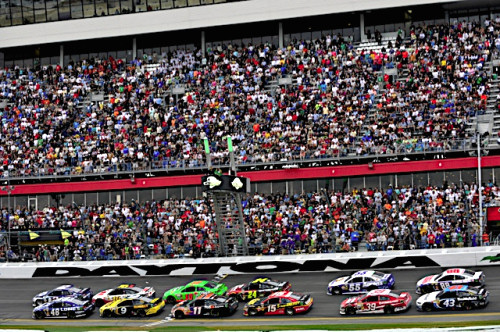The Way It Is/ NASCAR's richesby Gordon Kirby |
 NASCAR may have its problems with declining TV ratings and crowds also continuing to fall at many races. The upcoming retirements of Jeff Gordon and Tony Stewart will also present a challenge for NASCAR's popularity and ratings.
NASCAR may have its problems with declining TV ratings and crowds also continuing to fall at many races. The upcoming retirements of Jeff Gordon and Tony Stewart will also present a challenge for NASCAR's popularity and ratings.
Without doubt, sponsorship dollars these days are nothing like as strong as they were during NASCAR's heydays seven and fifteen years ago. Yet in this changing environment NASCAR's star drivers continue to enjoy healthy incomes. Various sources suggest that at least 14 Sprint Cup drivers will earn more than $10 million in base salary this year. NASCAR's most popular driver Dale Earnhardt Jr. will earn around $14.5 million from Hendrick Motorsports this year before prize money and endorsements. Six-time champion Jimmie Johnson is said to make a base salary from Hendrick this year somewhere between $13 million-$19 million while four-time champion Jeff Gordon is reported to earn a minimum of $13.2 million from Hendrick this year. Other NASCAR drivers earning a base salary of more than $10 million this year are Carl Edwards, Kyle Busch, Matt Kenseth and maybe Denny Hamlin with Joe Gibbs Racing; Brad Keselowski and Joey Logano with Team Penske; and Danica Patrick, Kevin Harvick and Tony Stewart with Stewart/Haas. Also said to be in the $10 million bracket are Ryan Newman, Martin Truex, Clint Bowyer and Jamie McMurray.  © Autostock Four-time champion Gordon has won more prize money than any other driver in NASCAR history. In 2009, after 17 years on the circuit, he became the first NASCAR driver to reach $100 million in career winnings. By the end of this year, his 23rd in the Sprint Cup series, he will have won more than $150 million. Six-time Jimmie Johnson is a close second in career prize money and should surpass Gordon next year. Three-time champion Tony Stewart is a distant third winning around $120 million over his career. The stars of the past made much less. 'Million Dollar' Bill Elliott is ranked 19th on NASCAR's all-time prize money list with a total of $46 million while seven-time champion Dale Earnhardt is 23rd earning $42 million in prize money over his career. 'The King' Richard Petty with seven championships and a record 200 wins to his credit is 29th on the money list with $8.5 million in prize money over 35 years between 1958-'92. But you can be sure Petty has made a good deal of additional pocket change over the years from endorsements, appearances and TV commercials. It's also worth noting that Hendrick Motorsports is paying almost $50 million in annual driver salaries with Joe Gibbs and Stewart/Haas not far behind. One can only assume the top teams are able to pay their drivers such stout numbers because the stars of the sport enable the teams to attract and foster major sponsors. How, you might ask, does IndyCar stack up? For many years Indy car racing used to boast about and publish its prize money numbers but those days vanished amid the CART/IRL war. IndyCar doesn't publish any such figures and the last listing I can find comes from Champ Car's final media guide in 2007. At the time Al Unser Jr. was at the top of the list with career earnings of $18,828,406. Michael Andretti was a close second with $18,338,119 followed by Bobby Rahal ($16.3 million), Emerson Fittipaldi ($14.3 mill), Paul Tracy ($12.6 mill), Jimmy Vasser ($12.1 mill), Mario Andretti ($11.5 mill), Rick Mears ($11.0 mill), Danny Sullivan ($8.9 mill) and Arie Luyendyk ($7.7 mill).  © Autostock So today's top NASCAR drivers make as much money in base salaries as the top Indy car stars from the last quarter-century earned over their entire careers! It's a sobering fact that emphasizes how much NASCAR--despite its problems--has completely blown Indy car racing into the weeds. NASCAR also takes great strength from a stable, well-established schedule. Most Sprint Cup races are successful events enjoying longterm date equity in sharp contrast to IndyCar's woeful schedule. And while both IndyCar and Formula 1 continue to survive with only ten teams, NASCAR profits from as many as 25 teams fielding more than 40 cars every weekend. Five teams--Hendrick, Gibbs, Stewart/Haas, Childress and Roush-Fenway--collectively field 18 cars and another ten teams run two cars apiece accounting for 20 more cars. So in spite of falling TV numbers and poor crowds at some races, NASCAR still has plenty of strength. Despite Gordon and Stewart's retirements NASCAR will continue to set the gold standard for many years to come as the definition of American motor racing. |
|
Auto Racing ~ Gordon Kirby
Copyright ~ All Rights Reserved |
